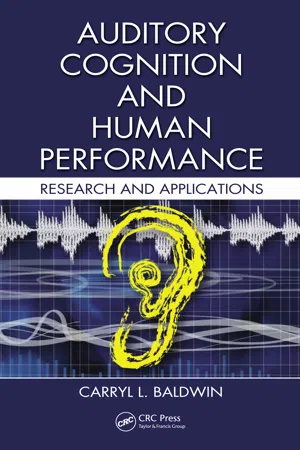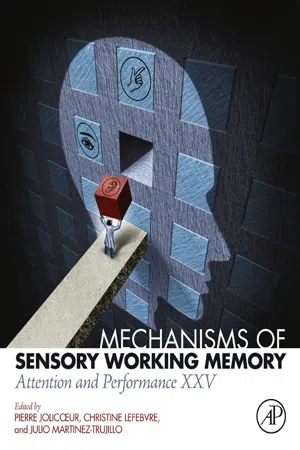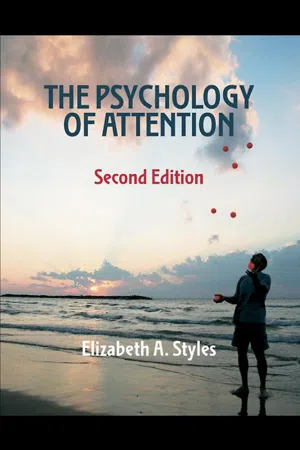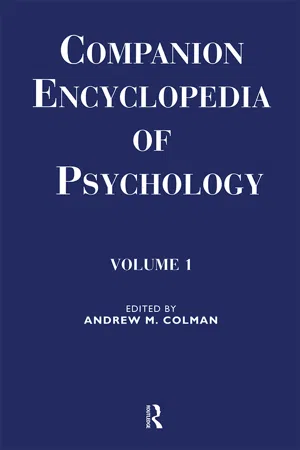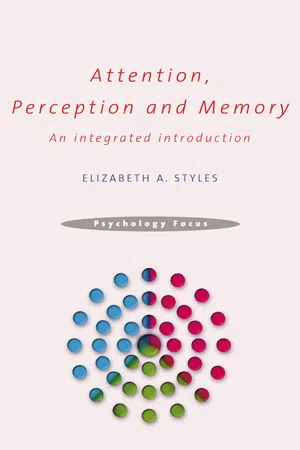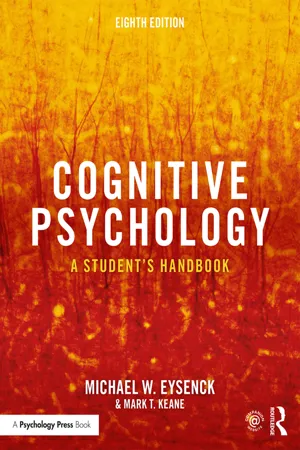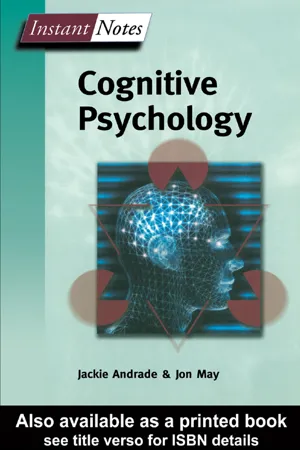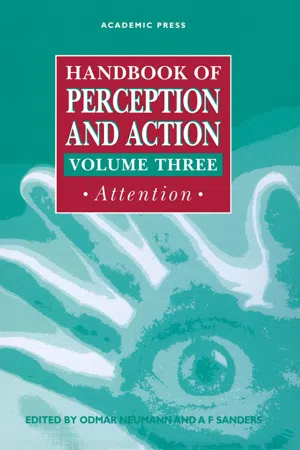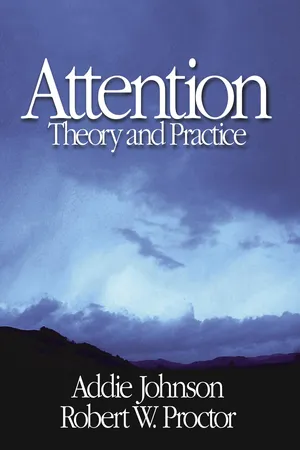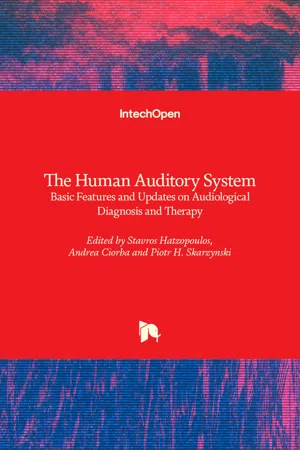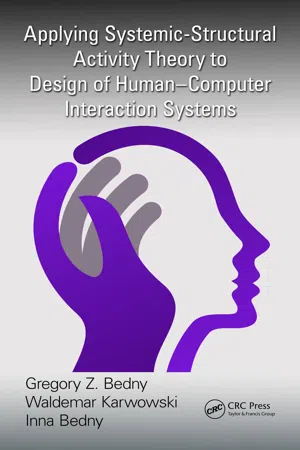Psychology
Auditory Attention
Auditory attention refers to the cognitive process of selectively focusing on auditory information while filtering out irrelevant sounds. It involves the ability to concentrate on specific auditory stimuli, such as speech or music, while ignoring competing sounds. This process is essential for effective communication, language processing, and auditory perception.
Written by Perlego with AI-assistance
Related key terms
1 of 5
12 Key excerpts on "Auditory Attention"
- eBook - PDF
Auditory Cognition and Human Performance
Research and Applications
- Carryl L. Baldwin(Author)
- 2016(Publication Date)
- CRC Press(Publisher)
53 4 Auditory Cognition The Role of Attention and Cognition in Auditory Processing INTRODUCTION In this chapter, the discussion of auditory processing begun in the last chapter is continued by examining the role that attention plays in helping to identify and select an acoustic pattern of interest. Next, higher-order processes involved in audition, which can be viewed as the real heart of auditory cognition, are discussed. Some would go as far as to call these abilities auditory intelligence (de Beauport & Diaz, 1996), suggesting that as humans we vary in our ability to interpret and find mean-ing in the sounds we hear. Viewed in this way, auditory intelligence involves the degree to which we are able to go beyond merely hearing sounds to higher-order processing—involving not only taking in sounds, but also “words, tones of voice, and arriving at a sophisticated or comprehensive meaning … and connecting inner meaning to a sound received from the outer environment” (de Beauport & Diaz, 1996, p. 45). Individuals may differ in their ability to construct meaning from sound because of talent or experience, but regardless, the same basic processes are used by all listeners. Auditory cognition begins with our attending to an acoustic stimulus. Without such attention, further cognitive processing is unlikely. Therefore, we begin our dis-cussion by examining attentional mechanisms in selective listening and the role that studies of selective listening have played in the development of theories of attention and information processing. ATTENTION It should be clear by now that listening requires more than simply passively receiv-ing an auditory stimulus. A host of complex processes is involved in extracting and making sense of the acoustic environment. Selective attention plays one such impor-tant role in auditory pattern perception. - eBook - ePub
Mechanisms of Sensory Working Memory
Attention and Perfomance XXV
- Pierre Jolicoeur, Christine Lefebvre, Julio Martinez-Trujillo(Authors)
- 2016(Publication Date)
- Elsevier(Publisher)
Maeder et al., 2001 ). It is thus possible that working memory may also maintain and manipulate particular features of a sound object (e.g., pitch, spatial location, intensity) independently of other features. After that discussion, we will review studies that focused on cognitive processes that are a hallmark of working memory (e.g., maintenance, manipulation), detailing their similarities and differences from attention. Finally, we review studies that focused on directly manipulating the cognitive processes underlying attention or working memory and assessed how such manipulation affects performance and/or brain activity.Current Views of Auditory Attention
Early work on Auditory Attention sought to understand how one can selectively attend to a conversation in the midst of other, less relevant sounds in the environment. This is illustrated by the cocktail party scenario (Cherry, 1953 ), in which a listener can readily focus his or her attention on one conversation while filtering out less relevant co-occurring conversations. Typically, speech comprehension in noisy environments is constrained by our capacity to hold critical information online in working memory while keeping irrelevant information (external stimuli or internal thought) from intruding. For effective speech reception to take place, listeners must be able to group sound elements coming from one source together (i.e., one speaker) and segregate those from other sources (e.g., another speaker). Current theories of auditory selective attention posit facilitation as well as suppression mechanisms that possibly have an important role in parsing concurrent sound sources as well as enhancing figure-ground segregation when focusing attention to someone amidst a conversational background (Alain, Arnott, & Dyson, 2013 ). Studies using fMRI have revealed attention-related changes in modality-specific and supra-modal areas including the prefrontal and parietal cortices (e.g., Hill & Miller, 2010 ; Petkov et al., 2004 ; Salmi, Rinne, Koistinen, Salonen, & Alho, 2009 ; Tzourio et al., 1997 ). Although modality-specific areas are important for sound segregation to occur (e.g., Alain et al., 2005 ; Gutschalk et al., 2005 ), the supra-modal brain areas are likely important for controlling the flow and organization of sensory information in modality-specific areas and deploying attention to task-relevant information (Alain et al., 2013 - eBook - ePub
- Elizabeth Styles, Elizabeth Styles(Authors)
- 2006(Publication Date)
- Psychology Press(Publisher)
Chapter 3 , but normally the orienting of visual attention is overt and attention is coincident with fixation. However, with auditory information it is the cochlea and the specialised organs within it that deal with extracting details of the input. (See Moore, 1995 for an overview of the hearing system.) Orienting to a sound must operate differently to visual orienting, first, because of the nature of auditory stimuli and, second, because we cannot move our ears. Although we can orient our head this is only a very gross response. Orienting to an auditory stimulus must rely on selectively directing analysis of some feature of the auditory environment.Scharf (1998) provides a useful review of the psychoacoustical approach to Auditory Attention and argues that understanding Auditory Attention presents a greater challenge than understanding visual attention. He points out that if listening, or paying Auditory Attention, is an internal act with no apparent peripheral muscular changes, then it is a “wholly cognitive act”.It is well known that both endogenous and exogenous cueing of the position in which a visual target will be presented speeds detection and improves accuracy. Knowing in advance where to direct visual attention allows cortical enhancement of the region of cortex responsible for the processing of stimuli at the cued location (e.g. Posner, 1980). In auditory experiments, attention can be directed to features such as stimulus frequency or to the direction from which a sound comes. We shall discuss a possible mechanism for selective tuning of the auditory system after consideration of some of the experimental data on listener’s ability to orient to auditory stimuli.Orienting attention to frequency
In Auditory Attention, many studies have measured detection and discrimination when a particular frequency is to be attended. When a listener knows in advance the frequency of an upcoming signal, detection requires a lower threshold for detection. Tanner and Norman (1954) measured a listener’s ability to detect a 1000-Hz tone occurring during one of four possible intervals. The listener had to indicate during which of the time periods the signal was detected. The sound level was set such that accuracy was about 65%. Listeners knew the frequency they should be listening for and could therefore endogenously prepare for it. However, after several hundred trials the frequency of the tone was changed to 1300 Hz and detection rate dropped to chance levels. However, as soon as the listeners were given an example of a 1300-Hz tone and told that this was what to listen for performance reverted to 65%. This example shows that Auditory Attention can be “tuned” to focus on a particular frequency and that this focusing reduces the probability of detecting other neighbouring frequencies. We could think of this effect as similar to focusing the spotlight of visual attention at an expected location. - eBook - ePub
Companion Encyclopedia of Psychology
Volume One
- Andrew M. Colman(Author)
- 2018(Publication Date)
- Routledge(Publisher)
4.2 AttentionMichael W. Eysenck Royal Holloway, University of London, Surrey, England- Focused Auditory Attention
- Some theoretical views
- Focused visual attention
- Feature integration theory
- Inhibitory processes
- Divided attention
- Theoretical accounts
- Absent-mindedness
- Vigilance
- Further reading
- References
The term "attention" has been used in a number of different ways. It is sometimes used to mean concentration, as in the expression "Pay attention!" A related use of the term is as a process that varies as a function of an individual's level of arousal: someone who is aroused is attentive to his or her environment, whereas someone who is low in arousal or drowsy is not. However, the most common usage of attention is in connection with selectivity of processing. This usage was emphasized by the nineteenth-century psychologist William James (1890):Everyone knows what attention is. It is the taking possession of the mind, in clear and vivid form, of one out of what seem several simultaneously possible objects or trains of thought. Focalisation, concentration, of consciousness are of its essence. It implies withdrawal from some things in order to deal effectively with others, (pp. 403-404)In order to investigate how efficiently we are able to attend selectively, researchers have conducted much research on focused attention. In such research, subjects are presented with two or more sets of stimuli at the same time. They are instructed to process one set of stimuli while ignoring the other set or sets. The amount of processing of the to-be-ignored stimuli which occurs provides an indication of how successfully attention can be focused on the stimuli that the experimenter has identified as important.Another issue which is important in attention research concerns the number of things that can be attended to at the same time. Once again, William James (1890) had an important contribution to make: - eBook - ePub
Attention, Perception and Memory
An Integrated Introduction
- Elizabeth Styles(Author)
- 2004(Publication Date)
- Psychology Press(Publisher)
However, attentional processes are also involved in allowing us to selectively listen to one source of sound rather than other. Walking in the garden you can intentionally control what you listen to. You may listen to the birds, then switch attention to listening to the wind in the trees, then back to your friend’s chatter. Most of the time one sound source is the focus of attention, and is in the foreground, which other sources merge into the background. As you switch between the sounds, what appears to be in the background or foreground changes places. However, if there is a sudden noise, for example an apple falling to the ground, this will automatically capture your attention. We have already looked at endogenous and exogenous control of attention in Chapter 5, concerning visual attention. While there are some important differences between hearing and vision, these modalities interact in some interesting ways. For example, if you are trying to hear what someone is saying to you in a noisy environment it helps if you can see their lips moving, so attending to sounds can be improved if we also attend to visual properties of the same object. Auditory Attention When we search a visual scene, we can move our eyes and head to bring the fovea to focus on the part of the environment that we wish to attend to. If we want to ignore a visual stimulus we can shut our eyes, or look away. However, this is not the case with the auditory environment. The cochlea has no equivalent of the fovea, and we cannot shut our ears or move them around. So how are we able to selectively attend to objects or locations in the auditory environment? Scharf (1998) suggests that the auditory system is ‘an excellent early warning system, one that is ready to receive and process stimuli from all directions regardless of an organism’s current orientation’ - No longer available |Learn more
- Philip Banyard, Christine Norman, Gayle Dillon, Belinda Winder, Philip Banyard, Christine Norman, Gayle Dillon, Belinda Winder(Authors)
- 2019(Publication Date)
- SAGE Publications Ltd(Publisher)
As you might expect, given all the jobs attention is involved in, there is no one single mecha- nism at work, but many (Allport, 1993). Attention is involved in both choice and awareness, and operates both explicitly (overtly and intentionally) and implicitly (covertly and without intent). So, when choosing to read this chapter, you stop overtly attending to the music playing behind you or the chair you are sitting on, though you know they are both there (did you suddenly feel your chair?). But if the music stopped or the chair broke you would be immediately aware, so you must be attending to them at some level (covertly). Chalmers (1996) has suggested that conscious attention allows us to process objects for action (e.g. open the book to read) and that unconscious attention sustains automatic reactions (e.g. reaching out to stop or cushion your fall when the chair breaks). Attention is operating all the time, though you may not be aware of everything. In due course we will see intriguing examples of what happens when attention is faulty (neglect), how attention does not work the way you might think it should (change blindness and inattentional blindness), and what all this says about attentional processing. But first we will look at the development of attention research, beginning with Auditory Attention. 6.5.1 Auditory Attention Interest in Auditory Attention was sparked following Cherry’s (1953) research into the cocktail party effect. This is the problem of how we can follow what one person is saying when there are several people speaking in the same room. Indeed, it is quite remarkable how, in the busy room soundscape, we are able to focus on one conversation and ignore the rest of the noise, and then just as easily switch to another conversation across the room AN INTRODUCTION TO SENSATION, PERCEPTION AND ATTENTION 137 just because it’s more interesting. - eBook - PDF
Cognitive Psychology
A Student's Handbook
- Michael W. Eysenck, Mark T. Keane(Authors)
- 2020(Publication Date)
- Psychology Press(Publisher)
Second, the approach provides only a partial explanation of the underlying mechanisms causing the various factors to influence representa- tional quality. CHAPTER SUMMARY • Focused Auditory Attention. When two auditory messages are presented at the same time, there is less processing of the unattended than the attended message. Nevertheless, unattended messages often receive some semantic processing. The restricted processing of unattended messages may reflect a bottleneck at various stages of processing. However, theories assuming the existence of a bottleneck de-emphasise the flexibility of selective Auditory Attention. Attending to one voice among several (the cocktail party problem) is a challenging task. Human listeners use top-down and bottom-up processes to select one voice. Top- down processes include the use of various control processes (e.g., focused attention; inhibitory processes) and learning about structural consistencies present in the to-be-attended voice. • Focused visual attention. Visual attention can resemble a spotlight or zoom lens. In addition, the phenomenon of split attention suggests visual attention can also resemble multiple spotlights. However, accounts based on spotlights or a zoom lens typically fail to specify the underlying mechanisms. Visual attention can be object-based, space-based or feature-based, and it is often object-based and space-based at the same time. Visual attention is flexible and is influenced by factors such as individual differences. According to Lavie’s load theory, we are more susceptible to distraction when our current task involves low perceptual load and/or high cognitive load. There is much support for this theory. Interactive exercise: Definitions of attention 232 Visual perception and attention However, the effects of perceptual and cognitive load are often not independent as predicted. In addition, it is hard to test the theory because the terms “perceptual load” and “cognitive load” are vague. - eBook - ePub
- Jackie Andrade, Jon May(Authors)
- 2004(Publication Date)
- Taylor & Francis(Publisher)
Section C Attention
DOI: 10.4324/9780203488294-3C1 Auditory Attention
Keynotes
Selective Auditory Attention Mechanisms of selective attention allow us to concentrate on one auditory message while ignoring other messages that differ in terms of speaker’s voice and location, thus solving the so-called cocktail party problem. Our ability to hear someone mention our name even when we are attending to another conversation suggests that even the ignored message or conversation undergoes some processing. Dichotic listening experiments have explored the extent of this processing. Theories of selective attention Early research suggested very little processing of the unattended message in dichotic listening experiments, leading Broadbent to argue that selection occurs early, at the level of sensation rather than perception. Tests of Broadbent’s model revealed more extensive processing of the unattended message, leading to proposals of late selection or a flexible bottleneck in processing. Jones has emphasized the effect of the nature of the distracting material on our ability to selectively attend, arguing that attention involves maintaining target and distractor information in separate streams. Related topics Sensation (B1 )Auditory perception (B2 )Divided attention and dual task performance (C3 ) Selective Auditory Attention
Cherry (1953) used simultaneous presentation of two messages to investigate the problem known as the cocktail party phenomenon - eBook - PDF
Handbook of Perception and Action
Attention
- Odmar Neumann, A. F. Sanders(Authors)
- 1996(Publication Date)
- Academic Press(Publisher)
I still find an intermittent noise more irritating than a continuous one. But by now I have so steeled myself against all these things that I can even put up with a coxswain's strident tones as he gives his oarsmen the rhythm. For I force my mind to become self-absorbed and not let outside things distract it...' (Seneca: Epistulae Morales ad Lucilium, translated by Robin Campbell, pp. 109-110). 108 G. ten Hoopen 4.2 Significant Literature Bregman's (1990) monumental work Auditory Scene Analysis has no chapter on attention, but the whole book is pervaded by an air of attention which condenses in his last chapter. Deutsch wrote a fine tutorial chapter ('Auditory pattern recognition') in the Handbook of Perception and Human Performance, vol. 2 (1986); there is a subsection (1.4) titled 'Grouping and selective attention'. Handel (1989) wrote a nice textbook, Listening, concerned with speech and music perception. There is no chapter called 'Auditory Attention', but chapter 7 ('Breaking the acoustic wave into events: stream segregation') is relevant to our topic. Less recent but relevant is also Warren's book Auditory Perception: A New Synthesis (1982). Two books on music psychology are also relevant. Sloboda's (1985) The Musical Mind: The Cognitive Psychology of Music contains a section 'Attention in music listening'. Dowling and Harwood's (1986) Music Cognition has a chapter 'Melody: attention and memory', but the next chapter, 'Melodic organization', is also concerned with the topic of attention. The impressive work of Jones is very pertinent to the topics presented. To recall only a few titles: 'Time, our lost dimension: Toward a new theory of perception, attention, and memory' (her 1976 article in Psychological Review), 'Dynamic attending and responses to time' (Jones and Boltz, 1989, in Psychological Review), and 'Musical events and models of musical time' (in Block, 1990). - eBook - PDF
Attention
Theory and Practice
- Addie Johnson, Robert W. Proctor(Authors)
- 2003(Publication Date)
- SAGE Publications, Inc(Publisher)
Crosstalk between information processes seems to be possible at just about any level of information processing. Although this may argue against a strict modularity of processing systems, it does not prove the existence of a master controller. Together, the two ears function as an early warning system and facilitate omni-directional orienting. Separately, the two ears offer the advantage of two distinct channels for studying information processing. Much early research on attention took advantage of the availability of two separate processing channels for hearing to study a range of issues, including the locus of attentional selection and the fate of unattended information. This research showed that despite the fact that people can select information on the basis of simple features, such as stimulus location or auditory pitch, the semantic content of nonselected information is also processed. Whereas visual stimuli can be detected and identified only in the region to which the person is attending, auditory stimuli originating from any direction rela-tive to the person can be perceived with approximately equal ease. Once alerted to the presence of something by its sound, a person generally will want to look in the direction of the sound for further investigation. Thus, Auditory Attention may play a role in visual selection. Because the functions of auditory and visual attention are clearly linked, much research has focused on interactions in processing between the two modalities. One important finding is that capacity limits in recognition are more pronounced when multiple stimuli must be processed within one modality rather than across different modalities. This suggests that there may be separate attentional resources for visual and auditory information. On the other hand, cross-modal cuing effects suggest that modality specificity may be graded or that there may be a supra-modal attentional controller. - eBook - PDF
The Human Auditory System
Basic Features and Updates on Audiological Diagnosis and Therapy
- Stavros Hatzopoulos, Andrea Ciorba, Piotr H. Skarzynski, Stavros Hatzopoulos, Andrea Ciorba, Piotr H. Skarzynski(Authors)
- 2020(Publication Date)
- IntechOpen(Publisher)
25 Attention and Working Memory in Human Auditory Cortex DOI: http://dx.doi.org/10.5772/intechopen.85537 and directions for future research. Psychological Bulletin. 2014; 140 (2):339-373. DOI: 10.1037/a0034221 [33] Treisman AM. Strategies and models of selective attention. Psychological Review. 1969; 76 (3):282 [34] Broadbent DE. Perception and Communication. New York: Pergamon Press; 1958. p. 338 [35] Bharadwaj HM, Lee AK, Shinn-Cunningham BG. Measuring auditory selective attention using frequency tagging. Frontiers in Integrative Neuroscience. 2014; 8 :6. DOI: 10.3389/ fnint.2014.00006 [36] Woods DL, Alain C, Diaz R, Rhodes D, Ogawa KH. Location and frequency cues in auditory selective attention. Journal of Experimental Psychology: Human Perception and Performance. 2001; 27 (1):65 [37] Zatorre RJ, Mondor TA, Evans AC. Auditory Attention to space and frequency activates similar cerebral systems. NeuroImage. 1999; 10 (5):544-554 [38] Zatorre RJ, Bouffard M, Ahad P, Belin P. Where is’ where’in the human auditory cortex? Nature Neuroscience. 2002; 5 (9):905 [39] Maddox RK, Atilgan H, Bizley JK, Lee AK. Auditory selective attention is enhanced by a task-irrelevant temporally coherent visual stimulus in human listeners. eLife. 2015; 4 :1-11. DOI: 10.7554/eLife.04995 [40] Kong L, Michalka SW, Rosen ML, Sheremata SL, Swisher JD, Shinn-Cunningham BG, et al. Auditory spatial attention representations in the human cerebral cortex. Cerebral Cortex. 2014; 24 (3):773-784. DOI: 10.1093/ cercor/bhs359 [41] Awh E, Pashler H. Evidence for split attentional foci. Journal of Experimental Psychology: Human Perception and Performance. 2000; 26 (2):834 [42] Conway AR, Cowan N, Bunting MF. The cocktail party phenomenon revisited: The importance of working memory capacity. Psychonomic Bulletin & Review. 2001; 8 (2):331-335 [43] Alain C, Izenberg A. Effects of attentional load on auditory scene analysis. - eBook - PDF
- Gregory Z. Bedny, Waldemar Karwowski, Inna Bedny(Authors)
- 2014(Publication Date)
- CRC Press(Publisher)
169 5 Attention as a Self-Regulative System 5.1 Mechanisms of Attention and Strategies of Information Processing Relationship to the study of attention in psychology changed depending on the dominant theoretical approach in psychology. For example, behaviorism, which for long period of time dominated in psychology, rejected the concept of attention as mentalist category in psychology. However, with the emer-gence of cognitive psychology, and especially after the work of Broadbent (1958) perception and communication interest to the problem of attention sharply increased. It should be noted that there are some difficulties associated with the study of attention. This is explained by the fact that attention encompasses a broad range of phenomena. This field of study has no clear boundaries and it often is difficult to separate attention from the consideration of other mental processes. The term attention encompasses such phenomena impor-tant for the study human work as selectiveness, concentration, switching, dividing, sustaining, etc. Due to the variety of phenomena of attention and its properties, it becomes important the selection of it’s the most important aspects in the study of human work. In this chapter, we want to demonstrate the usefulness of integrating ideas of cognitive psychology to the ideas of activity theory (AT) in the study of attention. This integration is especially evident in the study of human work. More specifically, we pay attention to application SSAT and some ideas of cognitive psychology in the study of attention. Here, cognitive approach will be combined with functional analy-sis when attention is described as a goal-directed self-regulative system. The study of attention is important from both theoretical and applied per-spectives. It can be useful to study such factors as automation, prediction of multi-task performance, cognitive efforts, and complexity of task.
Index pages curate the most relevant extracts from our library of academic textbooks. They’ve been created using an in-house natural language model (NLM), each adding context and meaning to key research topics.
